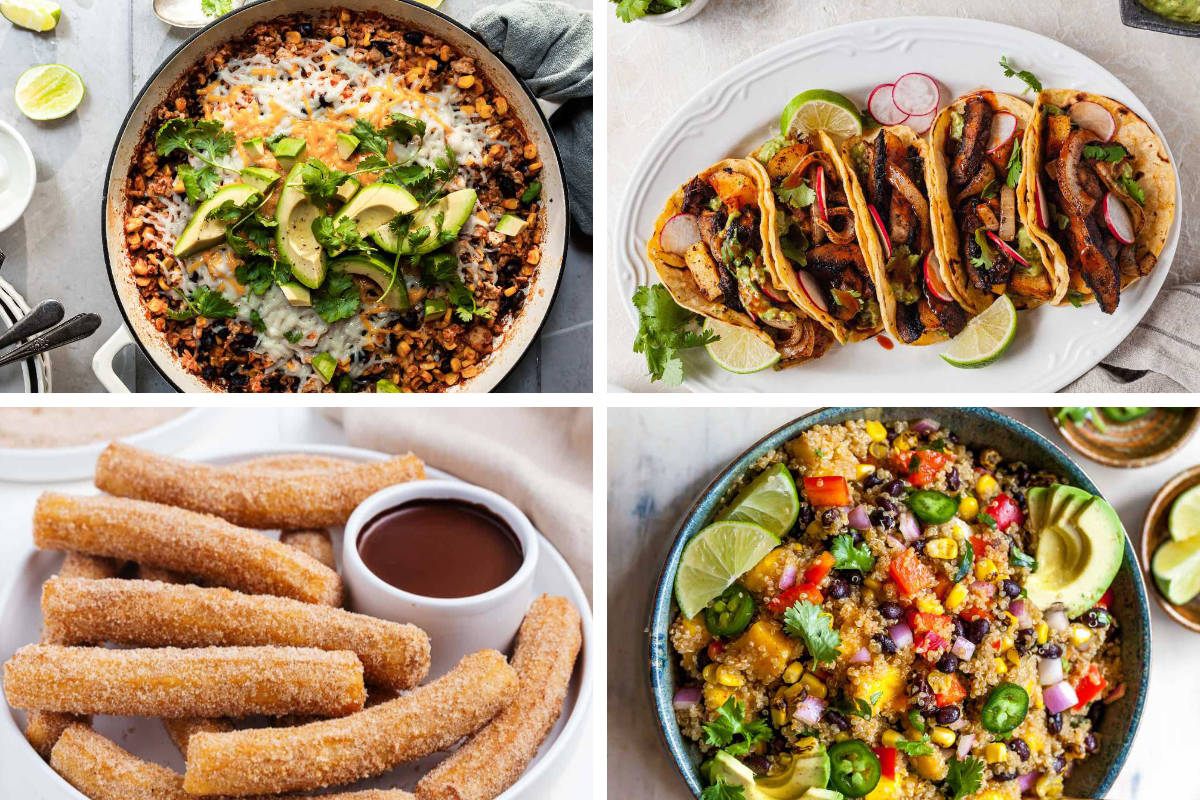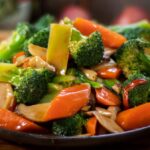Embark on a culinary journey through the vibrant world of Mexican vegetarian cuisine! Discover a treasure trove of recipes bursting with fresh, bold flavors, showcasing the incredible versatility of plant-based ingredients. From classic dishes reimagined with a vegetarian twist to innovative creations that will tantalize your taste buds, this exploration delves into the heart of Mexican culinary tradition, offering a delicious and satisfying experience for vegetarians and adventurous eaters alike. Prepare to be inspired by the rich tapestry of textures and aromas, as we unlock the secrets to creating truly unforgettable Mexican vegetarian meals.
This guide will take you through the top five flavorful vegetarian Mexican dishes, revealing their key ingredients and unique flavor profiles. We’ll explore essential ingredients, providing recipes to showcase their versatility, and guide you step-by-step through the creation of a signature dish. We’ll also journey through the regional variations of Mexican vegetarian cooking, highlighting the distinct ingredients and techniques used across different regions of Mexico. Finally, we’ll provide serving suggestions and flavor pairings to elevate your Mexican vegetarian dining experience to new heights.
Top 5 Flavorful Vegetarian Mexican Dishes

Mexican vegetarian cuisine offers a vibrant tapestry of flavors, textures, and colors, far exceeding the expectations of simple side dishes. These dishes are hearty, satisfying, and bursting with the unique tastes of Mexico, proving that vegetarian food can be incredibly flavorful and exciting.
Five Standout Vegetarian Mexican Dishes
The following table showcases five incredibly popular vegetarian Mexican dishes renowned for their rich and complex flavor profiles. Each dish presents a unique culinary experience, highlighting the versatility and deliciousness of plant-based Mexican cooking.
| Dish | Description | Key Ingredients | Visual Representation |
|---|---|---|---|
| Quesadillas | A simple yet endlessly adaptable dish, quesadillas are essentially folded tortillas filled with cheese and other ingredients, then grilled until golden brown and crispy. | Corn or flour tortillas, Oaxaca cheese, various fillings (onions, mushrooms, peppers, etc.) | Imagine two golden-brown tortillas, slightly puffed from the heat, enclosing a molten pool of melted Oaxaca cheese, its creamy texture contrasting with the crisp exterior. Scattered throughout are vibrant flecks of sautéed onions and peppers, their colors adding visual interest to the warm, inviting dish. |
| Tacos al Pastor (vegetarian adaptation) | Traditionally made with marinated pork, this vegetarian version uses marinated jackfruit or mushrooms to mimic the texture and slightly sweet, smoky flavor of the original. | Jackfruit or mushrooms marinated in achiote paste, pineapple, and spices, served in warm corn tortillas with onions, cilantro, and salsa. | Picture warm, soft corn tortillas cradling succulent pieces of marinated jackfruit, glistening with achiote paste’s reddish-orange hue. The vibrant green of cilantro and the bright red of salsa add pops of color against the deep brown of the jackfruit, creating a visually appealing and appetizing dish. |
| Enchiladas Verdes | Corn tortillas are filled with cheese or vegetables, then smothered in a vibrant green tomatillo sauce and baked until bubbly and delicious. | Corn tortillas, cheese or vegetables (potatoes, squash, etc.), tomatillos, onions, garlic, chiles, cilantro. | Envision a baking dish brimming with rolled enchiladas, their golden-brown tortillas peeking out from under a lush, vibrant green tomatillo sauce. The sauce is speckled with tiny flecks of cilantro and perhaps a hint of red from a mild chili, creating a visually appealing contrast of colors and textures. |
| Chile Rellenos | Large poblano peppers are roasted, peeled, and filled with a savory mixture, then dipped in batter and fried until golden and crispy. | Poblano peppers, cheese, onions, spices, egg batter. | Imagine a plump, roasted poblano pepper, its dark green skin slightly blistered from the roasting process, filled with a creamy, golden cheese mixture. The pepper is then coated in a light, golden-brown batter, creating a visually appealing contrast between the deep green of the pepper and the crisp, golden-brown exterior. |
| Elote (Mexican Street Corn) | Grilled corn on the cob is slathered in a creamy, flavorful sauce and topped with cotija cheese, chili powder, and lime juice. | Grilled corn on the cob, mayonnaise or crema fresca, cotija cheese, chili powder, lime juice, cilantro. | Picture a charred ear of corn, its kernels glistening with a creamy, white sauce. Sprinkled liberally over the corn are bright white crumbles of cotija cheese, contrasting with the deep red of the chili powder and the vibrant green of the cilantro. The whole presentation exudes a rustic charm. |
Exploring Regional Variations in Mexican Vegetarian Cooking
Mexican vegetarian cuisine, far from being a monolithic entity, boasts a vibrant tapestry of regional styles, each reflecting the unique terroir and culinary traditions of its area. The availability of ingredients, historical influences, and indigenous culinary practices all contribute to the remarkable diversity found across the country. This exploration delves into the distinctive characteristics of vegetarian cooking in three key regions: Oaxaca, Yucatan, and Puebla.
Regional Vegetarian Cooking Styles: Oaxaca, Yucatan, and Puebla
A comparison of vegetarian cooking styles across these three regions reveals fascinating differences in both ingredients and techniques. Oaxaca, known for its rich biodiversity, emphasizes the use of corn, beans, and an array of native vegetables and chiles in its dishes. Yucatan, influenced by Mayan traditions and proximity to the Caribbean, incorporates tropical fruits, achiote paste, and distinctive spices into its cuisine. Puebla, a region steeped in colonial history, showcases a blend of indigenous and European influences, resulting in dishes that are often richer and more complex.
| Region | Unique Ingredients & Techniques | Example Vegetarian Dishes & Distinctive Flavors |
|---|---|---|
| Oaxaca | Abundant use of corn (in various forms, including tortillas, tamales, and atole), black beans, a wide variety of chiles (e.g., pasilla, ancho, chipotle), epazote (a distinctive herb), various mushrooms and squash varieties, mole sauces (often vegetarian or easily adaptable). Techniques often involve slow cooking and the skillful blending of spices. | Tlayudas (large, crispy corn tortillas topped with refried beans, cheese, lettuce, and salsa), Memelas (thick corn tortillas topped with various toppings), Mole Negro (a rich, complex sauce, often made vegetarian with the omission of meat). The flavors range from smoky and earthy to intensely rich and complex, depending on the chosen chiles and spices. |
| Yucatán | Extensive use of tropical fruits (e.g., plantains, mangoes, pineapple), achiote paste (which lends a vibrant red color and earthy flavor), xcatic (a Mayan herb with a slightly peppery flavor), pumpkin seeds, and corn. Techniques include slow cooking, grilling, and the use of unique spice blends. | Sikil P’aak (a creamy dip made from pumpkin seeds, roasted tomatoes, and chiles), Quesadillas Yucatecas (often featuring cheese and other vegetables), Relleno Negro (a rich, dark stew, traditionally made with turkey but easily adapted to be vegetarian). The flavors are often vibrant, tangy, and subtly spicy, with a distinct earthiness from the achiote paste. |
| Puebla | Corn, beans, various chiles (e.g., poblano, ancho), pumpkin seeds, various cheeses, and a wider range of European-influenced ingredients (e.g., herbs, spices). Techniques often involve complex layering of flavors and the use of rich sauces. | Chiles en Nogada (poblano peppers stuffed with a savory mixture and topped with a walnut sauce – a vegetarian version is easily made by omitting the meat), Mole Poblano (another rich mole sauce, often containing nuts and seeds, adaptable for vegetarian diets), Esquites (a delicious street food of corn kernels, chiles, cheese, and mayonnaise). The flavors in Puebla’s vegetarian dishes are frequently rich, complex, and often subtly sweet and savory. |
Serving Suggestions and Flavor Pairings for Vegetarian Mexican Meals
Elevating a delicious vegetarian Mexican meal goes beyond simply plating the food; it’s about creating a harmonious symphony of flavors and textures that tantalize the palate. Careful consideration of serving suggestions and complementary flavor pairings can transform a good meal into an unforgettable culinary experience. This section explores creative serving ideas and ideal flavor pairings for a variety of vegetarian Mexican dishes, enhancing their inherent deliciousness.
Pairing dishes and beverages thoughtfully enhances the overall dining experience. The vibrant flavors of Mexican vegetarian cuisine lend themselves beautifully to a range of accompaniments, creating balanced and exciting meals. Consider the intensity of the main dish’s spices when selecting sides and drinks to avoid overwhelming the palate or creating an unbalanced flavor profile.
Serving Suggestions for Popular Vegetarian Mexican Dishes
The presentation of a dish significantly impacts the dining experience. Consider the visual appeal alongside the taste. For example, a vibrant esquites (Mexican street corn salad) served in small, colorful ceramic bowls offers both visual and textural appeal. Similarly, nopales (cactus paddles) can be artfully arranged on a platter, showcasing their unique texture and vibrant green color. Think about height and layering to add visual interest to your plates.
- Quesadillas: Fold them into triangles for a classic look, or cut them into smaller squares for easier sharing. Garnish with fresh cilantro and a dollop of sour cream or Mexican crema for added richness.
- Enchiladas: Arrange them neatly on a platter, drizzled with a vibrant red or green sauce, and sprinkled with crumbled queso fresco. A scattering of chopped onions and cilantro adds a fresh contrast.
- Tacos al Pastor (vegetarian): Use colorful tortillas, and arrange the filling attractively. Garnish with finely chopped pineapple, onions, and cilantro for a burst of color and flavor.
- Tostadas: Layer the toppings artfully, creating height and visual interest. A colorful arrangement of beans, salsa, avocado, and lettuce creates a feast for the eyes.
- Burritos: These can be served whole or cut in half, revealing the colorful filling inside. A side of guacamole and pico de gallo adds to the visual appeal and flavor complexity.
Ideal Flavor Pairings: Sides, Beverages, and Accompaniments
The success of any Mexican vegetarian meal hinges on thoughtful pairings. Acids cut through richness, while contrasting textures add excitement. Consider these suggestions to elevate your dining experience.
- Spicy Dishes: Pair with cooling sides like a simple lime and cilantro rice, a refreshing avocado salad, or a creamy Mexican rice to balance the heat. A crisp, cold Mexican lager or a light, fruity margarita can also help to temper the spice.
- Rich Dishes: Dishes with creamy sauces or cheese benefit from lighter sides such as a simple salad with a citrus vinaigrette, or grilled vegetables. A dry rosé wine or a light-bodied beer can complement these richer flavors without overwhelming them.
- Earthy Dishes: Dishes featuring mushrooms or other earthy vegetables pair well with bright, acidic elements. A salsa fresca, a pico de gallo, or a quick-pickled onion relish can add a vibrant counterpoint. A crisp white wine or a refreshing agua fresca (fruit-infused water) complements these flavors beautifully.
Sample Vegetarian Mexican Menu with Flavor Pairings
This menu showcases a variety of vegetarian Mexican dishes and their suggested pairings, illustrating the principles discussed above.
- Appetizer: Esquites (Mexican street corn salad) with lime wedges and cotija cheese. Paired with a Paloma cocktail (tequila, grapefruit soda, lime).
- Main Course: Vegetarian Enchiladas Verdes (green enchiladas) with a creamy tomatillo sauce. Paired with Mexican rice and refried beans, alongside a crisp Sauvignon Blanc.
- Side Dish: Grilled nopales (cactus paddles) with a chipotle-lime dressing.
- Dessert: Churros with chocolate sauce. Paired with a strong Mexican coffee.
From the zesty tang of a perfectly prepared salsa verde to the comforting warmth of a hearty bean stew, Mexican vegetarian cuisine offers an explosion of flavors and textures that will delight your senses. This exploration has unveiled the secrets to creating vibrant, flavorful vegetarian dishes rooted in the rich traditions of Mexico. Whether you’re a seasoned cook or a kitchen novice, these recipes and techniques will empower you to create authentic and satisfying meals that are both delicious and deeply satisfying. So, gather your ingredients, embrace the vibrant colors, and prepare to embark on a culinary adventure that celebrates the best of Mexican vegetarian cooking.
Question & Answer Hub
What are some good substitutes for cheese in vegetarian Mexican dishes?
Excellent substitutes for cheese in vegetarian Mexican dishes include queso fresco, crumbled cotija, or even a creamy avocado sauce.
Can I make these recipes ahead of time?
Many Mexican vegetarian dishes are even better the next day! Soups, stews, and fillings can be made ahead and reheated.
Where can I find authentic Mexican ingredients?
Check your local Latino markets or specialty grocery stores for a wider selection of authentic Mexican ingredients.
Are these recipes suitable for gluten-free diets?
Many of these recipes are naturally gluten-free, but always check ingredient labels to ensure they meet your dietary needs. Corn tortillas are a great gluten-free option.


